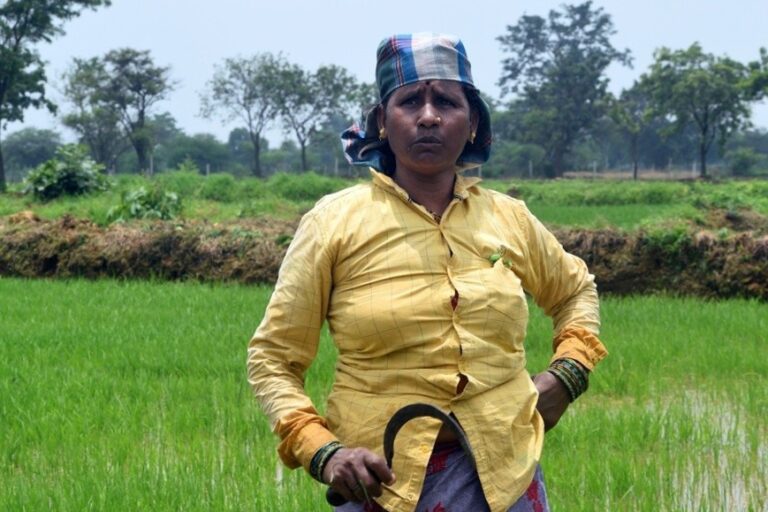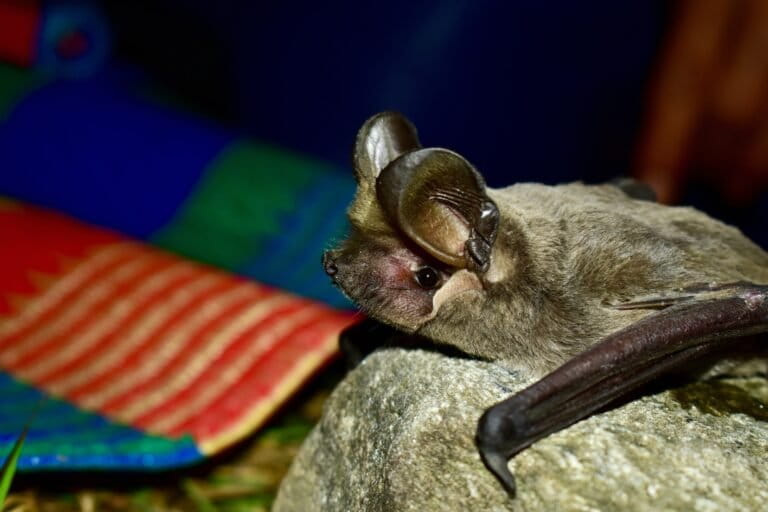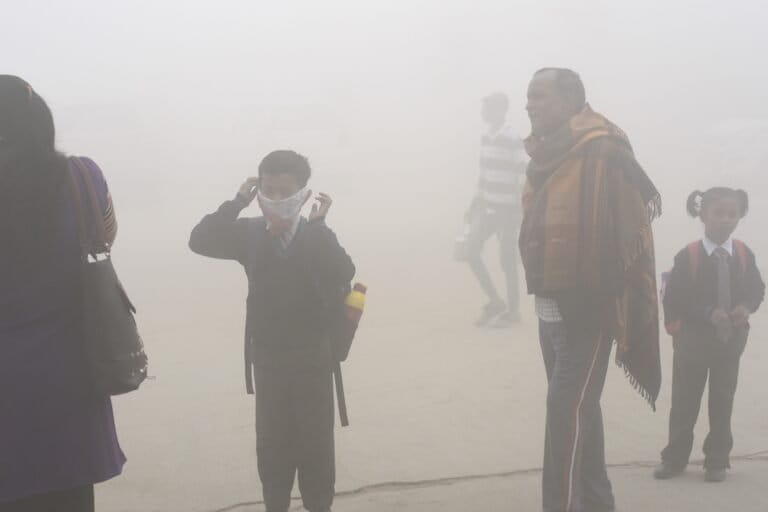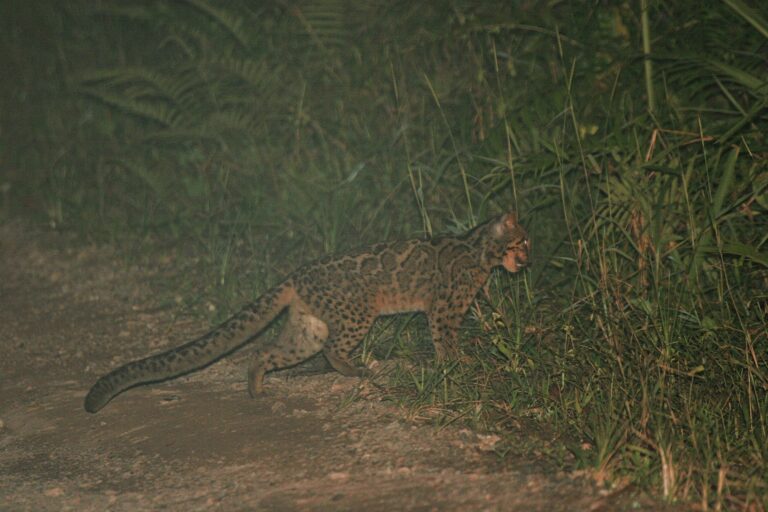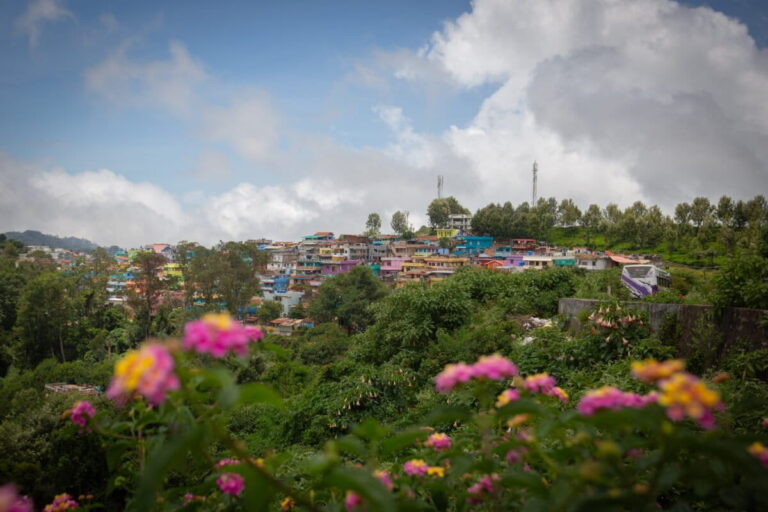- Local hunting and illegal wildlife trade have decimated wildlife populations in forests throughout the tropics, and often, vulnerable species have been extirpated.
- While evidence of human-driven animal extinctions date back to 125,000 years ago in Africa, the earliest records of human-driven extinctions in Asia date back to 40,000 years ago.
- Compared to other Asian countries, India has strong wildlife protection laws, but wildlife law enforcement varies depending on the region, protected area and the legal status of the forest in question.
- In this part-review, part-commentary, scientists Aparajita Datta and Rohit Naniwadekar from the Nature Conservation Foundation discuss their observations from working extensively in northeast India: the different socio-cultural aspects of hunting, the depth of indigenous knowledge and the importance of involving local communities in conservation.
Hunting poses a significant risk to wildlife persistence in four-fifths of the remaining tropical forests on earth. Eighty percent of these tropical forests lie within a 20-km radius of a human settlement, which is often the average distance a hunter would traverse to hunt. Local hunting and illegal wildlife trade can result in local extirpations and drive species to extinction. Wildlife populations have declined in forests throughout the tropics due to hunting, and often, vulnerable species have been extirpated, resulting in what is called the ‘empty forest syndrome’. These are forests that are structurally intact but functionally defunct. Such forests are more silent, there are fewer calls, few animal signs and tracks, one may also find undispersed fruits and seeds below tree canopies.
Many of the species targeted for hunting play important ecological roles in the ecosystem as carnivores, herbivores and seed dispersers. The extinctions are often size-biased as larger animals are more vulnerable to hunting. Loss of large vertebrates in the tropics, many of which are herbivores and seed dispersers, can have cascading impacts on plant communities.
Hunting in Asia
While evidence of human-driven animal extinctions date back to 125,000 years ago in Africa, the earliest records of human-driven extinctions in Asia date back to 40,000 years ago. It was probably around then that the slow-moving Giant Pangolin Manis paleojavanica was driven extinct by humans. Apart from the hunting of large vertebrates, like deer, pigs and bovids (the cow family, like the Indian gaur), from records dating back to 45,000 years, studies have documented human hunting of primates, civets, rodents, pythons, and monitor lizards, highlighting pervasive, historical hunting.
Diverse methods, including the use of dogs, bow & arrow, traps, and smoking of fossorial mammals are traditionally used for hunting. The use of guns for hunting is a more recent phenomenon. Apart from hunting for meat, collection of animal body parts has been of interest to humans for the last two thousand years. Many animal body parts are used in traditional costumes and ceremonies of different South-east Asian communities.

While hunting has been extensively studied in the Americas and Africa, information is relatively limited from Asia and is mostly restricted to illegal wildlife trade. A 2018 study identified hunting as the main immediate threat for Asia’s endangered vertebrates and indicated that animal populations had declined considerably since the eighties with many species extirpated from parts of former ranges. They contended that overhunting due to improved forest access, hunting technology, markets and higher demand for wild meat, medicinal products, pets, and of high-value species was unsustainable and law enforcement is weak.
Hunting in north-east India
Compared to other Asian countries, India has strong wildlife protection laws, but wildlife law enforcement varies depending on the region, protected area and the legal status of the forest in question. Enforcement in the hilly northeastern states has been mostly limited. North-east India is geographically and culturally similar to South-east Asia, where wildlife hunting for consumption and trade is extensive and more open. However, local hunting is prevalent in other parts of India as well; researchers have documented both in southern India and Western Himalaya. Anecdotal and media reports suggest intensive hunting also occurs in parts of eastern and central India.
The north-eastern region is known for its biological richness with two biodiversity hotspots – Indo-Myanmar and the Himalaya, and has a relatively low human population density. While it comprises only 8 percent of the country’s area, it makes up a fourth of India’s forest cover. Forest cover in most north-eastern states is between 50 to 90 percent. These states harbour important biodiversity, with high species richness within faunal groups (nine wild cat species, 21 small carnivore species, 13 large herbivore/ungulate species, 12 primate species). Namdapha National Park, for instance, has 140 mammal and over 400 bird species, apart from the smaller vertebrate and invertebrates still being documented.
North-east India is India’s biological frontier with exploration surveys leading to description of many new species. Yet, somewhat paradoxically, it is a region, barring the state of Assam, where wildlife hunting is pervasive. The region shares international borders with Myanmar, Nepal, Bangladesh, China and Bhutan, which are along forested mountain ridges posing challenges to controlling cross-border wildlife trade.
Apart from biodiversity, the cultural and linguistic diversity is also tremendous. More than 220 ethnic groups reside here. Hunting has strong cultural roots in north-east India. Many tribal communities in north-east India have dedicated annual hunting festivals. However, often they also have strong taboos on hunting with respect to season and animal species. Species that are reported as taboo include the elephant, hoolock gibbon and other primates, Himalayan serow, tiger (often wild cats in general), hornbills, and squirrels, but this varies within and between communities.

Taboos can also break down depending on context such as when animals crop-raid or kill livestock; or due to generational change, change in religion or advent of migrants/outsiders. The Mishmis and several other communities have elaborate rituals that are performed after most hunting trips. In most areas, hunting hornbills during their breeding season is avoided. It is believed that such a trespass would incur the curse of the incarcerated female and chick, which are dependent on the male for food.
Studies assessing hunting impacts on animals and ecosystems have picked up in the last decade. However, considering the scale of hunting in north-east India, it has been relatively less-studied. Hunted animals vary in body size from giant wood spiders to elephants. Several studies have recorded numbers of species hunted: 134 species (mammals, birds and reptiles) from Nagaland, Mizoram and Arunachal Pradesh, 23 mammal species in western Arunachal Pradesh, 33 mammal species in 3 different sites in Arunachal Pradesh, 43 mammal species hunted in Nagaland and Arunachal Pradesh.
In a market survey, 35 bird species were recorded being sold in Nagaland. Given that even smaller birds (sunbirds, warblers) are often hunted and consumed, these numbers are an underestimate. While molluscs and amphibians are primarily hunted in the monsoon, the main hunting season for large vertebrates is winter when people are free from farming activities.
The motivations for hunting vary from local meat consumption, hunting for body parts of animals (e.g. Great Hornbills Buceros bicornis for its casque or tail feathers worn as part of traditional attire), for illegal wildlife trade (elephants and rhinoceros for their ivory and horn respectively), retaliatory killing of crop-raiding animals (e.g. wild pigs Sus scrofa), medicinal value of body parts, for cash to meet basic needs or as recreation.
Impacts of hunting
Although there is limited quantified data, hunting can have significant impacts on wildlife abundance and persistence in the region. Most studies have mainly documented numbers of species hunted and details of practices and patterns. Local people along the Indo-Myanmar border confirmed the presence of the Sumatran Rhinoceros Dicerorhinus sumatrensis in the recent past, which have become extinct from the region. In Nagaland, a skull of the Sumatran Rhinoceros, hunted decades ago, was seen, highlighting that hunting pressures can drive large-bodied species to local extinction. During the ethnic conflict around Manas Tiger Reserve in the 1990s, one-horned rhinoceros were hunted out.

Clear impacts have been shown for some species such as reduction in hornbill encounter rates/densities between protected areas and less-protected Reserved forests although these comparisons are confounded by the occurrence of logging in the more hunted sites. Possible local extirpations of hornbills have been documented from good forested habitats in Arunachal and across other states in North-east India. Studies comparing large mammal abundances between protected areas and community-managed lands have also shown that large mammals fare better in protected areas, while abundances of large mammals can be poor even in protected areas or vary between protected areas depending on the protection efforts.
In northern Myanmar, a 2005 study showed that hunting was indiscriminate and based on relative abundance of species rather than preference or protection status. Encounter rates for hunted species were inversely related to proximity to human habitation. Wild meat consumption was higher in winter months and barking deer, primates and wild pigs were the top three consumed species.
Trade in bear body parts is high in Arunachal Pradesh with a survey recording 701 body parts from 99 individual bears of two bear species. Such offtake levels are likely to affect populations. A 2010 study reported a decline in Orange-bellied squirrel due to hunting for medicinal use.
Two important groups targeted by hunting are herbivores and seed dispersers, both of which play an important role in governing plant community structure in tropical forests. Loss of seed dispersers has been demonstrated to negatively impact regeneration of fleshy-fruited plants dependent on them for seed dispersal. This results in shifts in plant communities from predominantly animal-dispersed plant species to abiotically dispersed plant species. The impacts and role of reduced herbivory on plant communities is little understood in India.
However, the narrative and evidence may be different in certain areas for some species.
A 2018 study describes the long-distance annual winter hunts for the takin (Budorcas taxicolor) that the Adis undertake in the context of their relationship with spirits and the natural world. This hunt is physically and mentally challenging and has a special significance in the community. Each village has designated different areas where they can hunt takin in their community-managed forests. The system ensures that it is not a free-for-all. A certain number is hunted annually. The impacts of these offtakes on takin populations have not been quantified. Notwithstanding the moral considerations that conservationists/outsiders may have to the takin hunting (which is a threatened protected species), this example needs to be better understood for a more evidence-based understanding of hunting impacts. The study also points to the changes in this activity due to increased road access and external factors.

Currently, much evidence on impacts of hunting remains anecdotal and subjective, depending on the perspective of the observer. The ubiquitous display of animal trophies among tribal communities often results in a misleading idea of hunting extent and impact. But these trophies are usually obtained over a long period. Second, many hunted individuals and smaller species are thrown away and not kept for display.
While local people in the north-east tend to prefer the taste of wild meat, it is a misconception that meat-eating is a daily affair. Daily meals consist of rice and local vegetables and sometimes fish. Wild meat is eaten on rare occasions. Most meals were of vegetables (60%) with wild meat consumed in only 9% of meals in local households in northern Myanmar, found a 2005 study. Domestic livestock is reared, but is not used for regular consumption, and usually kept for festivals, weddings or for sale.
Knowledge gaps
The existing studies have focussed on the larger vertebrate groups, yet most have only documented the number of species hunted and other parameters of hunting patterns and practices with no quantification of off-take of targeted species and the impacts on abundance of target species. A few studies have shown differences in densities between hunted and better protected sites. However, there is a need to study off-take rates of different animal groups and its consequent impacts on wild animal populations. This is a drawback of studies on hunting in India where offtake rates have not been estimated (numbers and biomass hunted over a given area in a time period). This is unlike studies in South America/Africa where offtake rates have been quantified by following hunters on their hunting trips.
In India, hunting is illegal in most areas and is a difficult subject to study due to legal and ethical factors. Even fewer studies have undertaken assessments of hunting of small birds, reptiles, amphibians and invertebrates. Turtles, tortoises and species like the Tokay gecko (Gekko gecko) are likely to be extremely vulnerable due to offtake for the illegal wildlife trade. In 2006, we heard of collections of beetles/butterflies in a locality in Arunachal being undertaken to sell to museums. Local people were being given Rs. 10 by external agents for every beetle they collected.

It is equally important to conduct ethnographical studies to document the diversity of hunting techniques, rituals, taboos and other cultural aspects associated with hunting and determine the temporal changes and their impacts with the advent of advanced technology, improved access, and cultural changes (e.g. religious conversion). It would also be useful to understand how the transition in people’s lifestyles, shift to an urban and market economy, and education have changed hunting intensity and patterns. It would be important to understand the changes in demand/supply dynamics, the key drivers and institutional and local systems of governance to stop or regulate hunting. Some insights have emerged from a few interdisciplinary studies, however, much more is needed.
The debate over hunting, its impacts and how to address it
Hunting is illegal in most of India and is usually referred to as poaching. Given the moral, and ethical value judgements against hunting by people from most of the rest of India, any hunting, whether it is subsistence or commercial, or whether it has real negative impacts is considered undesirable by many wildlife conservationists/forest authorities.
There is concern over the wide range of targeted species and the high hunting intensity. People argue that hunting and consumption of wild meat is increasingly indefensible and unsustainable. Under this view, it is advocated that hunting must be stopped through recourse to the law and enforcement.
However, there are several other aspects to local hunting. First, we need to understand that many communities have a utilitarian worldview of nature. There is a relationship with nature, observations are made and knowledge is gained from proximity to nature. At the same time, nature is viewed as a resource to be used or consumed. Notwithstanding the concern for depleting wildlife, some reflection is warranted before imposition of value-judgements on people who have their own. It is important to understand the socio-economic contexts under which different levels of hunting occur and the external drivers.
Second comes cultural history. If national wildlife laws are not in consonance with local societal values and customs – there will be a lag and it will take time for people to change. Prior to the Wildlife Protection Act of 1971, hunting was acceptable in other parts of India. Several hunters from the princely class later became passionate conservationists. It was even fashionable to hunt in the fifties and sixties. Many practices and customs take time to change as the society’s values and the contexts change. Hunting cannot be always stopped suddenly. Enforcement is not the only way to reduce hunting, given the deep-rooted and often historical socio-cultural factors involved. It is challenging to convince people to give up an important part of their way of life.
Hunting for commercial trade (musk deer, tiger, elephant, bears, pangolins and the Tokay gecko) is a serious issue. However, this targeted hunting is usually limited to fewer people in each community/site. It is often difficult to distinguish between “subsistence” and commercial hunting. People who are not regular hunters may go trapping for otters, musk deer, and bears to get cash for ‘subsistence’ living (basic needs or medical treatment). As the health facilities are often inadequate, private hospitals are preferred. For example, one man needed Rs. 12,000 for an appendix surgery for his son. So, an otter was killed.
While hunting is against the law, even government officials and politicians hunt or seek to buy wild meat and use animal products. Paradoxically, sometimes they do not officially acknowledge that hunting is a problem and are uncomfortable with discussions on the subject, even though privately they acknowledge it as an important issue.
How is hunting being addressed
Illegal wildlife trade for species like the tiger, elephant, rhino has been controlled in certain Protected Areas using strict patrolling and even armed enforcement by the Forest Department. In and around the Pakke Tiger Reserve, the Nyishi community, forest department and scientists/researchers are working together, to strengthen wildlife conservation. Local institutions have banned hunting and instituted fines. This would have been unheard of earlier when hunting was socially more acceptable. The wildlife laws existed– but the awareness and the societal acceptance of the law was minimal. The changes took time and only law enforcement by the Forest Department would not have helped in bringing about this change.
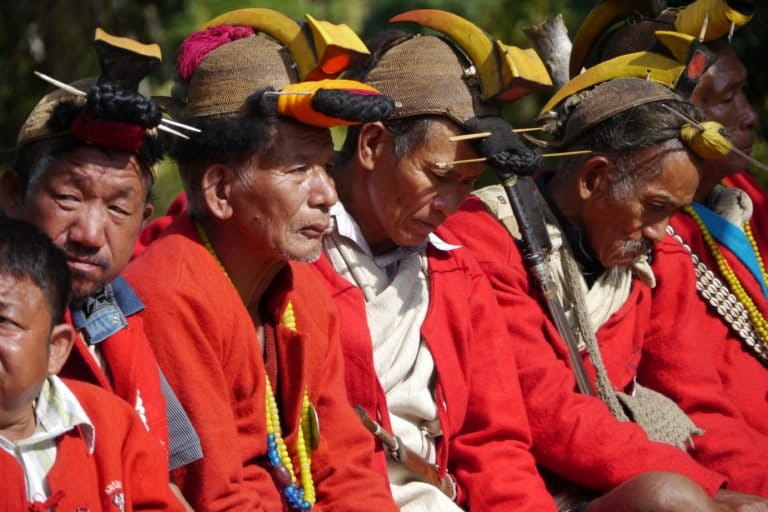
There are other initiatives across north-east India that have resulted in control of hunting though there is no quantitative data to show the results of such initiatives. Some of these are self-driven by the communities with or without the support of conservationists and organizations and/or state institutions, while others have been driven by external organizations and state institutions. In Nagaland, many Community-Conserved Areas have been declared through community institutions with some being strengthened by external organizations.
Villagers in Khonoma, Nagaland enforce hunting regulations, which has resulted in persistence of tragopans and other wildlife. However, in general, the efficacy of these community-imposed hunting bans in terms of wildlife population recovery has not been assessed. In places like the Ziro valley, the Apatani community through strong community organizations (like Ngunu Ziro) are making efforts to retain their cultural and natural heritage. A 2010 study reported on the decline of the Orange-bellied squirrel due to hunting but also how this led to hunting restrictions through the traditional village council. There are more examples of hunting bans imposed by villages in community lands in Arunachal: by the Berung, the Adi community and in Arunachal Pradesh.
The local Forest Department authorities along with conservationists have worked with the Bugun community to declare part of their forests as the Sinchung Bugun Village Community Reserve. Prior to reserve declaration, studies indicated declines of large mammals (tiger, otters and gaur) had occurred due to hunting, however these community-managed lands harboured smaller species of conservation importance.
The mass killing of Amur falcons in Nagaland was highlighted by conservationists and immediate action helped to stop the slaughter – but the co-operation of the Forest Department, local communities, and different Non-Governmental Organizations was needed to change the ground situation. However, most hunting (barring the annual hunting festivals in some areas) is not of this scale – it is low-intensity and by fewer people.
Recent studies have tried to understand hunting from an anthropological/socio-cultural perspective and understanding human-animal relationships such as among the Miju Mishmi, Adi and Idu Mishmi. Their work has uncovered relationships that these communities have with nature and their view of wild animals, hunting practices and patterns, their dynamic regulatory practices and customary laws for hunting which provides a nuanced and inter-disciplinary understanding which has lessons that can be of value in addressing the contentious issue of hunting. Their work has underlined the value of local institutions that can play an important role in controlling hunting and the need for forest authorities and conservationists to engage with these institutions.
Read Mongabay-India’s article on indigenous knowledge of the Adi community.
Aiyadurai (2018) says: “If the conservation groups take note of local people’s perceptions of animals, there could be a way forward to better and locally acceptable ways of conservation and that are likely to be more sustainable”. However, the role of these customary institutions is steadily being diluted through changes that are currently underway in Arunachal.
In most contexts, given other pressures on wildlife, hunting needs to be reduced or stopped. However, it is not always about law enforcement only and it requires a nuanced understanding and sensitivity. The few community-based conservation initiatives are important, but islands in terms of the bigger picture. There is a need to scale these efforts based on a more holistic inter-disciplinary understanding of hunting and ways to address it through engagement and dialogue with people. An interesting study by young Naga students suggests that education and awareness is important and a regional policy that takes into consideration conservation needs and local values/practices.
Most communities in the north-east are largely agriculturalists. Despite the changes, the extent of urbanization and development continues to remain much less than other parts of India, due to the geographical isolation and relative inaccessibility. However, there is an increasing rural and urban divide. Government policies often seek to wean people away from the forest. This may end up severing the relationships that people have had with nature.
Often, the best naturalists and observers of wildlife are the hunters. Sometimes hunting surveys have resulted in finding species that were not known to be present in the region. Several such ‘discoveries’ are often due to the natural history knowledge of hunters. They often tend to have more empathy and understanding. Unless we engage with them, we lose something of value.
We have worked with several remarkable tribal people who, once they had undergone a change of heart, became strong advocates for wildlife protection. It is important not to cut off dialogue with hunters who in many instances have become protectors and advocates for wildlife. By working with individuals from different communities we have come to understand to some extent, the individual motivations of hunters. Engaging with individuals directly and with their local institutions and customary laws maybe a more effective albeit difficult and slow strategy to bring about changes.
It is important that people continue to retain past connections with nature because unless people value that – it has fewer chances of remaining. Several examples of local initiatives are emerging and bring hope for conservation, not only because it helps wildlife but also because many people now appear to have a different relationship with nature out of concern, empathy, curiosity, and local pride. Many younger people are now engaged with ‘hunting’ and observing wildlife (including birds, butterflies and moths) with cameras and binoculars and taking pride in their natural heritage.
CITATION:
- Aiyadurai, A., Singh, N.J., & Milner-Gulland, E.J. (2010). Wildlife hunting by indigenous tribes: a case study from Arunachal Pradesh, north-east India. Oryx 44: 564–572.
- Aiyadurai, A. (2011). Wildlife hunting and conservation in Northeast India: a need for an interdisciplinary understanding. International Journal of Galliformes Conservation 2: 61-73.
- Aiyadurai, A. (2016). ‘Tigers are our brothers’: Understanding Human-Nature Relations in the Mishmi Hills, Northeast India. Conservation & Society 14: 305-316.
- Aiyadurai, A. (2018). Human-animal relations: a view from the Mishmi hills. Seminar 702, Feb, 2018.
- Chutia, P. (2010). Studies on hunting and the conservation of wildlife species in Arunachal Pradesh. SIBCOLTEJO 5: 56-67.
- Datta, A. (1998). Hornbill abundance in unlogged forest, selectively logged forest and a plantation in western Arunachal Pradesh. Oryx 32: 285-294.
- Datta, A. (2002). Status of hornbills and hunting among tribal communities in eastern Arunachal Pradesh. Unpublished report. Wildlife Conservation Society and WCS-India Program, Bangalore. Report submitted to the Forest Department of Arunachal Pradesh.
- Datta, A., Pansa, J., Madhusudan M.D. & Mishra, C. (2003). Discovery of the leaf deer Muntiacus putaoensis in Arunachal Pradesh: an addition to the large mammals of India. Current Science 84 (3): 101-102.
- Datta, A. (2007). Protecting with people in Namdapha: threatened forests, forgotten people. In Making Conservation Work: securing biodiversity in this new century (eds G. Shahabuddin & M. Rangarajan), pp. 165- 209. Permanent Black, New Delhi.
- Datta, A., Anand, M.O. & Naniwadekar, R. (2008). Empty forests: large carnivore and prey abundance in Namdapha National Park, Northeast India. Biol. Cons. 141:1429-1435.
- Datta-Roy, A. (2018a). Hunter-identity in a changing landscape. Seminar 702: 41-45, Feb 2018.
- Datta-Roy, A. (2018b). Swidden, hunting and Adi culture: Highland transitions in Arunachal Pradesh, India. PhD Thesis. Manipal Academy of Higher Education. 308 pp.
- Datta-Roy, A. (2019). Rethinking hunting in north-east India. https://round.glass/sustain/people/rethinking-hunting-northeast-india/
- Dollo, M., Gopi, G. V., Teegapalli, K. & Mazumdar, K. (2010). Conservation of the Orange-bellied Himalayan squirrel using a traditional knowledge system: a case study from Arunachal Pradesh, India. Oryx 44: 573-576.
- Harrison, R.D., Rachakonda, S., Brodie, J.F., Brook, S., Luskin, M., O’Kelly, H., Rao, M., Scheffers, B. & Velho, N. (2018). Impacts of hunting on tropical forests in Southeast Asia. Cons. Biol. 30: 972-981.
- Hilaluddin, Kaul, R. & Ghose, D. 2005. Conservation implications of wild animal biomass extractions in Northeast India. Animal Biodiversity & Conservation 28.2: 170-179.
- Madhusudan, M.D. & Karanth K.U. (2000). Hunting for an answer: is local hunting compatible with large mammal conservation in India. Hunting for sustainability in tropical forests 1, 339-355. Columbia University Press, New York.
- Madhusudan, MD & Karanth K.U. (2002). Local hunting and the conservation of large mammals in India. Ambio 31: 49-54.
- Mishra, C., Madhusudan, MD & Datta, A. (2006). Mammals of the high altitudes of western Arunachal Pradesh, Eastern Himalaya: an assessment of threats and conservation needs. Oryx 40: 1-7.
- Nijhawan, S. 2019. Tribal Tigers – How a shamanic community has saved tigers in the Dibang Valley of Arunachal Pradesh. Sanctuary Asia, April 2019, pp. 24-31.
- Kaul, R., Hilaluddin, Jandrotia, J.S. & McGowan, P.J. (2004). Hunting of large mammals and pheasants in the Indian Western Himalaya. Oryx 38: 1-6.
- Kumara, H.N. & Singh, M. (2004). The influence of differing hunting practices on the relative abundance of mammals in two rainforest areas of the Western Ghats, India. Oryx 38: 321–327.
- Rao, M., Myint, T., Zaw, T. and Htun, S. (2005). Hunting patterns in tropical forests adjoining the Hkakaborazi National Park, north Myanmar. Oryx 39: 292-300.
- Sethi, P. & Howe, H.F. (2009). Recruitment of hornbill-dispersed trees in hunted and logged forests of the Indian Eastern Himalaya. Conserv. Biol. 23: 710-718.
- Sethy, J. & Chauhan N. P. S. (2011). Use and trade of bear body parts: impact and conservation in Arunachal Pradesh state of India. International Journal of Bio-resource and Stress Management 2:409-415.
- Naniwadekar, R., Shukla, U., Isvaran, K., Datta, A. (2015a). Reduced hornbill abundance associated with low seed arrival and altered recruitment in a hunted and logged tropical forest. PLoS One 10, e0120062. https://doi.org/10.1371/journal.pone. 0120062
- Naniwadekar, R., Mishra, C., Isvaran, K., Madhusudan, M.D., and Datta, A. (2015b). Looking beyond parks: conservation value of ‘unprotected areas’ for hornbills in Arunachal Pradesh, Eastern Himalaya. Oryx 49: 303-311. doi:10.1017/S0030605313000781
- Naniwadekar, R. Datta, A., Raghunath, R., Teegalapalli, K., Ghosalkar, M., Borah, B & Lotha, L. (2016). Hornbill distribution in a biodiversity hotspot: Occupancy modelling for hornbills in north-east India. Report submitted to the Arunachal Pradesh Forest Department, March 2016. 47 pp.
- Velho, N., Ratnam, J, Srinivasan, U., Sankaran, M. (2012). Shifts in community structure of tropical trees and avian frugivores in forests recovering from past logging. Biol. Cons. 153: 32-40.
- Velho, N. & Laurance, W.F. (2013). Hunting practices of an Indo-Tibetan Buddhist tribe in Arunachal Pradesh, north-east India. Oryx 47: 389-392.
- Velho, N., Srinivasan, U., Singh, P. & Laurance, W.F. (2015). Large mammal use of protected and community-managed lands in a biodiversity hotspot. Animal Conservation 19: 199-208.
- Velho, N., Rachakonda, S., & Laurance, W.F. (2016). Terrestrial Species in Protected Areas and Community-Managed Lands in Arunachal Pradesh, Northeast India. Land 5: 35; doi:10.3390/land5040035
Banner image: A hunting trophy board. Several indigenous communities in north-east India display animal trophies as a cultural practice. However, this results in a misleading idea of hunting extent and impact – these trophies are usually obtained over a long period and not all individuals/species hunted are put on display. These trophy boards also may include domestic animals that are sacrificed for rituals. Photo by Rohit Naniwadekar.







